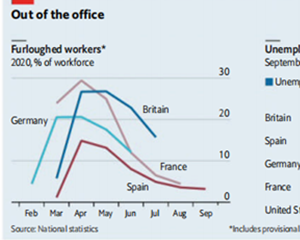Labour markets in Europe
歐洲的勞動(dòng)力市場(chǎng)
Pain relief
已止痛
The successes of furlough schemes—and their side effects
休假計(jì)劃的成功及其負(fù)面影響
So impressive is Germany's trading prowess that when the coronavirus pandemic struck, it even found something new to export: its short-time working scheme, or Kurzarbeit. Most OECD countries deployed such programmes this year, as they sought to avert mass unemployment and support workers' incomes during lockdowns. Those that had never had them, such as Britain, imported the idea wholesale. Others, such as Spain, drastically expanded access to existing programmes. America, however, went in another direction, preferring to increase the generosity of unemployment benefits.
德國(guó)的貿(mào)易能力十分驚人,在新冠肺炎襲擊之時(shí)竟然還能挖掘新的出口商品:即它的“短時(shí)工作計(jì)劃”,或者叫“縮時(shí)工作制”。為了防止封鎖期間出現(xiàn)大規(guī)模的失業(yè)并支持工人的收入,今年多數(shù)經(jīng)合組織成員國(guó)都部署了這一計(jì)劃。而那些從未有過(guò)該計(jì)劃的國(guó)家,比如英國(guó),直接批發(fā)了這一計(jì)劃。其它國(guó)家,比如西班牙,也極大地?cái)U(kuò)大了對(duì)現(xiàn)有計(jì)劃的訪問(wèn)。只有美國(guó)另尋他路,它更喜歡大方地增加失業(yè)救濟(jì)。
In April more than 26m workers in Britain, France, Germany and Spain were on furlough schemes, equivalent to a fifth of the workforce. While America's unemployment rate swelled from just over 3% in February to 14.7% in April, in Europe it barely budged.
4月,英國(guó)、法國(guó)、德國(guó)以及西班牙有2600多萬(wàn)名工人參與了休假計(jì)劃,該數(shù)字相當(dāng)于勞動(dòng)力總數(shù)的五分之一。同時(shí),該月美國(guó)的失業(yè)率已經(jīng)從2月的3%暴漲到了14.7%,而歐洲的失業(yè)率幾乎沒(méi)有變動(dòng)。
A few months on, how has the picture changed? In the big four countries nearly 11m workers were still on job-retention schemes in the summer, or 9% of the workforce. The numbers have fallen dramatically in France and Spain. By contrast, 15% of British workers were still furloughed in July, according to official data, a fifth of whom worked in the hospitality industry. A survey of employers suggests the share of furloughed workers fell to 11% in August.
幾個(gè)月過(guò)去了,情況發(fā)生了怎樣的變化?今年夏天,這四個(gè)大國(guó)中仍有1100萬(wàn)名工人(占勞動(dòng)力總數(shù)的9%)處在“短時(shí)工作計(jì)劃”中,而在法國(guó)和西班牙這一數(shù)字已經(jīng)急劇下降。相比之下,根據(jù)官方統(tǒng)計(jì),英國(guó)直至7月份仍有15%的工人在休假,其中有五分之一的人在服務(wù)行業(yè)工作。一項(xiàng)針對(duì)雇主的調(diào)查顯示,8月休假工人的比例已降至11%。

The furlough schemes were intended to freeze the labour market in place, covering the cost of workers so that bosses facing a temporary cash crunch during shutdowns did not have to sack them, and allowing for seamless recovery once economies reopened. Most people coming off the schemes indeed seem to have resumed work. Unemployment rates have edged up only a little as the number on short-time working schemes has fallen. Workforce participation has so far fallen very slightly, suggesting few were discouraged enough to leave the labour market altogether.
休假計(jì)劃的目的是凍結(jié)現(xiàn)有的勞動(dòng)力市場(chǎng),支付工人的成本,這樣在停工期間面臨暫時(shí)現(xiàn)金短缺的老板們就不必解雇他們,并能夠在經(jīng)濟(jì)重新開(kāi)放后實(shí)現(xiàn)無(wú)縫復(fù)蘇。大多數(shù)退出該計(jì)劃的人實(shí)際上似乎已經(jīng)重新回到工作崗位。隨著參與“短時(shí)工作計(jì)劃”的人數(shù)的下降,失業(yè)率小幅上升。迄今為止,勞動(dòng)參與度僅略有下降,這表明因受很大打擊而徹底離開(kāi)勞動(dòng)力市場(chǎng)的人極少。
Despite these successes, though, about 11m workers are still waiting to resume their normal working hours. The longer they are furloughed, the more likely it is that normality is not restored. Yet they have little incentive to find other work. In June economists at Allianz, an insurer, reckoned that up to 9m furloughed jobs in industries such as tourism and hospitality in Europe may be eventually culled.
然而,盡管取得了這些成功,仍有1100萬(wàn)名工人在等待恢復(fù)正常的工作時(shí)間。他們休假的時(shí)間越長(zhǎng),就越有可能無(wú)法恢復(fù)正常。而且他們也無(wú)意去找其它工作。6月,保險(xiǎn)公司安聯(lián)的經(jīng)濟(jì)學(xué)家估計(jì),歐洲的旅游業(yè)和酒店業(yè)等行業(yè)將有高達(dá)900萬(wàn)個(gè)被迫休假的工作崗位最終會(huì)被淘汰。
This suggests that the true unemployment rate in Europe is probably higher than official figures suggest. As an upper bound, if you were to assume that all of those still on furlough schemes are in fact out of a job, unemployment rates in the big four would rise to 12-20%. America's rate, in contrast, has gone in the opposite direction, falling from its peak in April to just below 8% in September.
這表明,歐洲的真實(shí)失業(yè)率可能要高于官方顯示的數(shù)據(jù)。作為上限,如果假設(shè)所有仍在休假計(jì)劃中的人實(shí)際上都失業(yè)了,那么四大國(guó)家的失業(yè)率將上升到12-20%。與之相反,美國(guó)的失業(yè)率自4月達(dá)到峰值后9月已降至略低于8%。
譯文由可可原創(chuàng),僅供學(xué)習(xí)交流使用,未經(jīng)許可請(qǐng)勿轉(zhuǎn)載。











